Anyone using/tried the E28-2G4M27S 2.4Ghz LoRa SX1280 27dB module?
-
@Larson KiCAD 6 allows for importing Eagle projects right from within KiCAD 6 itself. Not sure what options, if any, might exist for exporting to Eagle. I think you'll like KiCAD 6. It's pretty easy to pick it up--much easier than earlier versions. I previously used Diptrace, because it was so easy, but I've since moved completely over to KiCAD 6 because it's just as easy, but also more widely supported in terms of parts libraries. Also, unlike Diptrace, it makes sharing projects a snap--just create an archive (literally a one menu click operation), and share the resulting zip file.
-
@NeverDie said in Anyone using/tried the E28-2G4M27S 2.4Ghz LoRa SX1280 27dB module?:
Somehow I had gotten it in my head...
So many ways to cook an egg. The pleasure is in eating it. I'll take a picture of my wedding-cake-of-a-board stack when I finish. It may not be until July at my pace.
Re KiCAD: I look forward to trying. Recently JLCPCB made me learn EasyEDA and it really went well. Learning Eagle took me a week the first time, 2 days the second time, and still... I have to retrain. That is the joy of it all, right?
-
By the way, I've recently been reporting some other progress on the SX1280 on my radio-comparison thread: https://forum.mysensors.org/topic/11954/most-reliable-best-radio/27?_=1654402718278 For things that are both battery operated and subject to remote control, the importance of being able to quickly wake them up at a moments notice, but with minimal ongoing energy drain, is an important topic. Examples: key finder fobs, remotely opening/closing blinds at the push of a button, etc.
-
@NeverDie said in Anyone using/tried the E28-2G4M27S 2.4Ghz LoRa SX1280 27dB module?:
reporting some other progress
Yes, I have been there, though not lately. Thanks for the reminder. What great information and exchanges.
-
From the perspective of having some kind of general purpose platform--not just for testing but as a "go-to" for general use--it would be nice to have some kind of project box or enclosure of some kind for it. That would prevent things in the environment from pushing up against the electronics/PCB and possibly shorting it out. Anyone have any ideas on what form that should take? There's always the option of custom 3D printing something, but if there were a box of the right size already out there, that would be much easier. In that case one could customize the PCB to fit it precisely instead of 3D printing a box to precisely fit the PCB. Having a nice enclosure is one of the things that typically separates store-bought sensors from hobbyist projects.
By the way, the SHT45 TH sensor that I mentioned in the OP is now available on mouser. Unfortunately, it seems they nearly doubled their asking price over what they had earlier projected, so that's a bit of a disappointment. I guess these days a lot of chips are marked up due to the widespread shortages going on.... The chip itself is quite small, but it only has four landing pads, so I'm thinking that hand soldering it should be manageable. A simple adapter board, like this one for the SHT40, would allow it to easily fit the platform:
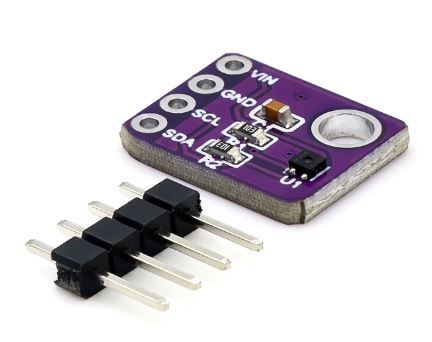
because the platform's pinout already anticipates adding up to two I2C devices without any fuss, like thus:
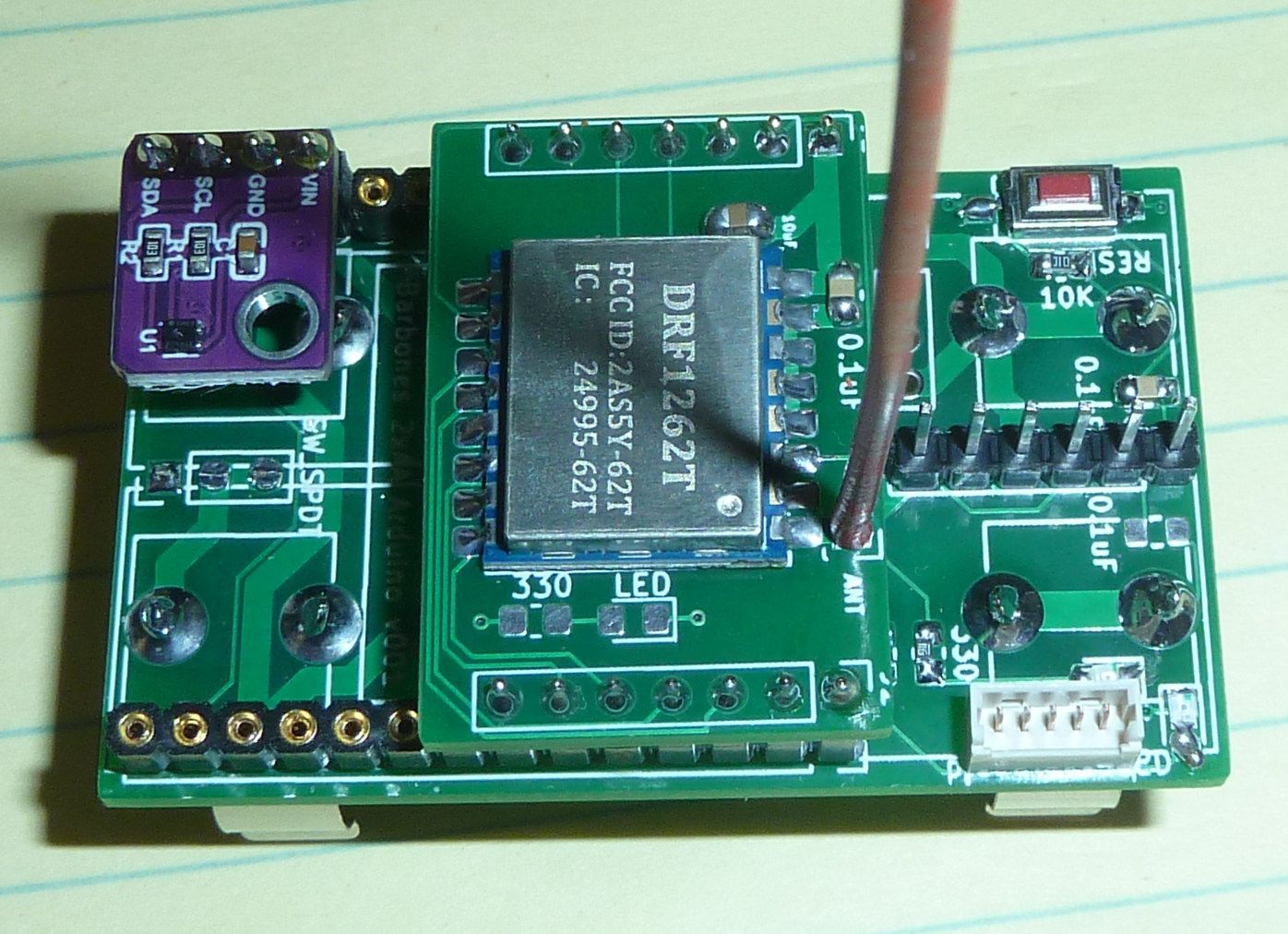
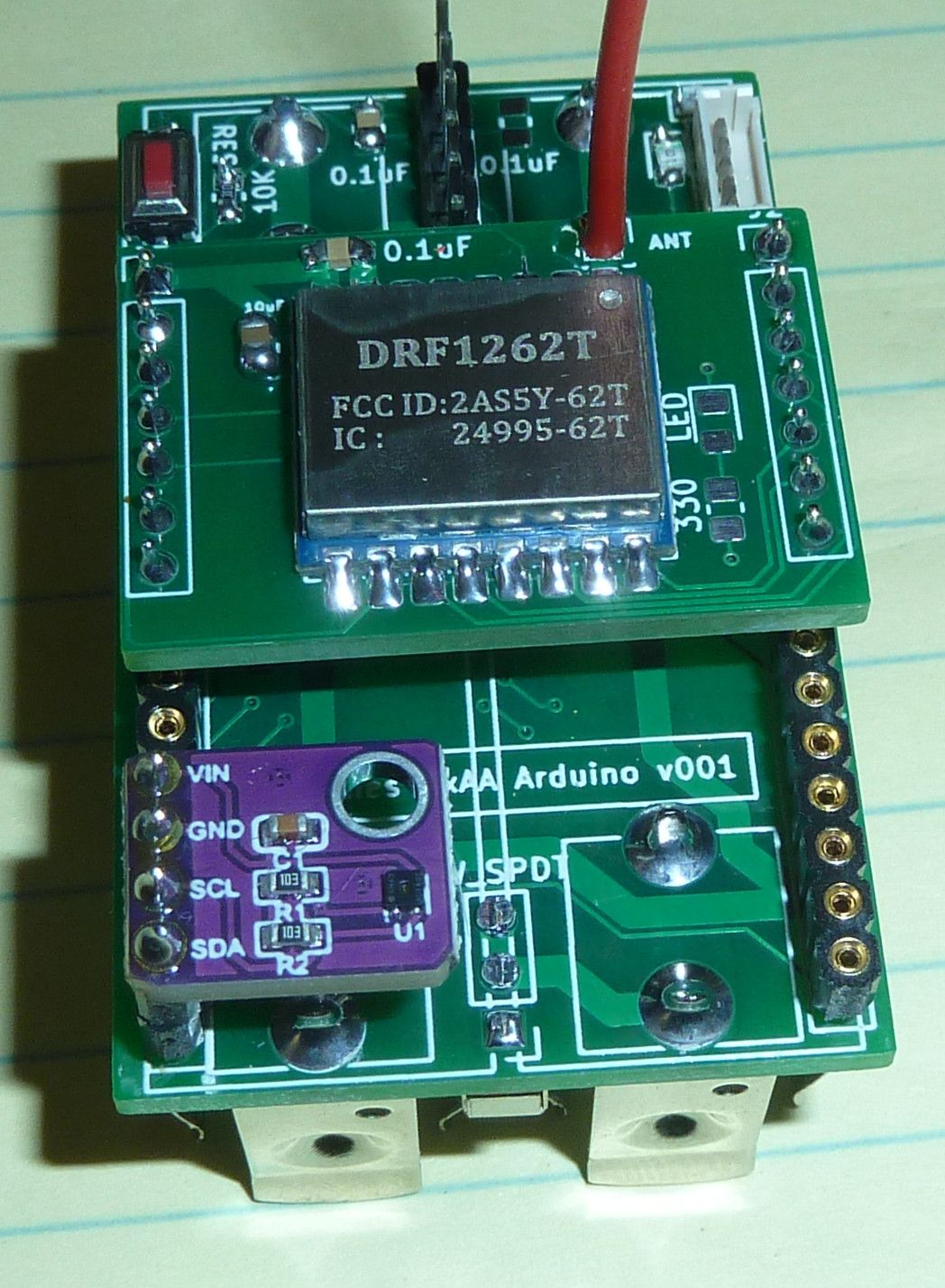
FYI, I updated the project page with a bunch of photos.
-
@NeverDie said in Anyone using/tried the E28-2G4M27S 2.4Ghz LoRa SX1280 27dB module?:
Anyone have any ideas on what form that should take?
Looks great! I’ve had good luck at Aliexpress with a variety of boxes like these. Some boxes have mounting lugs on the bottom. Your board has no space for mounting holes. I could help with the redesign??? Then I'd use stand-offs to get to the lugs and suspend the batteries in the air off the bottom. The antenna could be curled inside the box, but I've found that to have a negative impact (probably the polairity thing.
[Edit: Forgot to say that I've thrown in the little bags of desiccants for good measure. I find them in my pill bottles.]
-
@NeverDie I've made progress. I've ordered these items (mostly radios):
SX1278
SX1280
nrf24012mg E01's
nrf2401+
Bunch of antenna parts
TPL5110
Atmega328's
I cannot find any SX1262's and after your other post ("Best") I see that this is the darling to have. Any idea of where to find some?Fun to see the photos of the current meter in sleep action on your other post.
One addition I would like to make to your boards is a GPS chip. The idea would be to walk about in a field and collect RSSI and SNR data. Combining these elements would give a pretty good picture of signal vs the 2-dimensions of GPS data - for each radio and different modulations, spreading factors... Trouble here is that there are too many parameters to play with. I see Excel graphics coming into play. I have no experience with GPS, although I own a few of the chips.
-
The ones I've tried so far are these: https://www.ebay.com/itm/202574135410?hash=item2f2a5c0072:g:H9EAAOSwLuldcige Maybe it was luck, but the seller delivered fairly quickly, and they were very well packed. They allegedly contain TCXO's, so that presumably makes them better than those moules which don't have TCXO's.
I just today received these Ra-01SH, but haven't tried them yet: https://www.aliexpress.com/item/2255800961841511.html?spm=a2g0o.order_list.0.0.20411802pmZPEx&gatewayAdapt=4itemAdapt
I have custom adapter boards for them though. At the time I ordered them in April they were just $3.31 each, but now the same seller is asking $4.24. Delivery time was pretty long (longer than originally promised). So, you may want to shop around. If this is the new market rate, then I would go for the Dorji boards instead, because for the money you at least get TCXO's with the Dorji's, and they allegedly passed FCC. On the other hand, I've had good luck with Ai-Thinker in the past.There are some other brands out there as well, but these are the only two for which I made adapter boards.
-
@Larson I don't know how well GPS location works indoors, but it if somehow does that would be interesting. If it has gotten small enough and cheap enough and low power enough, it would be interesting for clock synchronization as well, though there are other ways of doing that.
-
Wow, I just checked, and GPS receivers have really gotten small, especially as compared to 5 years ago. Just 7mmx7mm in size: https://www.mouser.com/ProductDetail/Quectel/LG77LIAMD?qs=zW32dvEIR3sKRLNP92tehQ%3D%3D
That's way smaller than the old Adafruit one that I have: https://www.adafruit.com/product/5440
which is gigantic.
-
@NeverDie Thanks, once again. Done and purchased (4 1262's, and 2 1276's (ra-01SH)). I don't know why google and I couldn't find the1262's, nor Digikey, nor Ali, nor Amazon. So I'm on the slow road. I don't expect you to wait for me but your records in this forum are a standing education for all that follow. I'm sure I'll have observations/questions if you are still there.
Per my GPS thinking: I was thinking outdoors in an open field. I know your objective was through a reinforced footing, across the house, and up a floor. For that environment I would map the house into a grid with surveyor's cord and walk a defined pattern, clicking a button for every grid point I cross. Then I'd go to the yard with the same idea. My wife tells me I'm hard to live with... imagine that.
-
@Larson According to AI-thinker, the Ra-01SH is an SX1262, not a 1276. The SX1262's are more capable, whereas the 1276's are older generation. https://docs.ai-thinker.com/_media/lora/docs/ra-01sh_specification.pdf AFAIK, the two adafruit modules I got for trial purposes were SX1276's.
Since you'll be trying more than just the Ebyte module, let me know if you'd like me to post the other adapter boards also (e.g. for the Dorji SX1262, the Ra-01SH, and the nRF24L01). The work is already done.
-
@NeverDie said in Anyone using/tried the E28-2G4M27S 2.4Ghz LoRa SX1280 27dB module?:
That's way smaller than the old Adafruit one that I have: https://www.adafruit.com/product/5440
which is gigantic.At some point, like this, bigger is better for me. Imagine the size of the GPS in modern phones. I prefer the Adafruit type that has breakout pins and 'hold-my-hand' tutorials. We live in a golden age. I have to go find my GPS boards that i think I have. It has been some time and I've always wanted some purpose. This may be the time.
-
Definitely agree that it's the tutorials that make the adafruit hardware worthwhile, typically much more so than the hardware itself.
-
@NeverDie said in Anyone using/tried the E28-2G4M27S 2.4Ghz LoRa SX1280 27dB module?:
let me know if you'd like me to post the other adapter boards
The other adapter boards would be great... but I thought I'd earn my way into it by working with what you have already posted for the SX1280. To date I've been collecting pinouts to study the patterns so I could understand the template(s). What ever you post is a gift and I thank you. I'm sure that others to come will also enjoy. You have built quite a platform and I'm inspired.
-
@NeverDie said in Anyone using/tried the E28-2G4M27S 2.4Ghz LoRa SX1280 27dB module?:
According to AI-thinker, the Ra-01SH is an SX1262, not a 1276.
As I'm shoping around I found the Ra-01 Lora, but it was assocaited with the 1276 per this link you offered: https://www.aliexpress.com/item/2255800961841511.html?spm=a2g0o.order_list.0.0.20411802pmZPEx&gatewayAdapt=4itemAdapt&aff_fcid=d9908c021fe34eeeb0ea05b879ca4432-1654498510220-06752-_uYd1nh&aff_fsk=_uYd1nh&aff_platform=api-new-link-generate&sk=_uYd1nh&aff_trace_key=d9908c021fe34eeeb0ea05b879ca4432-1654498510220-06752-_uYd1nh&terminal_id=afb1662bfbca4bd68d5ee03a630ea8c7&afSmartRedirect=y.
Given that I haven't studied the datasheets, I don't exactly know the shape-shifting ability of one chip to act as another. Not sure where to go with this one - but I'll know more when they arrive. I'll work on it in the AM when I'm fresher.
-
@Larson When you hover over the different modules on that webpage, it will tell you the name of the model. They're all different.
-
@NeverDie Groovy. And good night. So much to learn.
-
@NeverDie said in Anyone using/tried the E28-2G4M27S 2.4Ghz LoRa SX1280 27dB module?:
Anyone have any ideas on what form that should take?
Second effort: This link shows a type of box with mounting points on the bottom. It would be nice if there were a PCB footprint for the holes, but I could find none. Using a paper rubbing and a set of calipers one can create their own footprint and build the PCB to that dimension. For any hard wires that must be passed through the box, I've been using cable glands like these for a waterproof enclosure. See the Cave Pearl Project for a different deep-sea approach,
-
I posted the rest of the radio module adapters to openhardware.io.
-
@Larson said in Anyone using/tried the E28-2G4M27S 2.4Ghz LoRa SX1280 27dB module?:
Not sure where to go with this one - but I'll know more when they arrive. I'll work on it in the AM when I'm fresher.
How confusing. On the EC-Buying Ali Store they show associations of the RA-01 with SX1262, SX1272, and SX1278 in titles on separate pages. Each of these pages show a variations on the RA-01 title (S, H, SH, SC...). I'll take your word for it. So it looks like all 6 radios I ordered last night are SX1262's then.
Found my GPS! It is really big & heavy too.
-
@NeverDie said in Anyone using/tried the E28-2G4M27S 2.4Ghz LoRa SX1280 27dB module?:
I posted the rest of the radio module adapters to openhardware.io.
Wow. Thanks. I'll be sure to report back on what I come-up with.
-
@NeverDie Been gone today so unable to play. Thanks again for generously sharing your work. I'm just now starting to look at the files: so cool! I like your broad power traces and skinny signal traces. And the pads on the radio chips are really tiny. I suspect these design choices are not accidental.
Look out OSH Park, here I come.
-
@Larson One thing Diptrace had that KiCAD lacks is a built-in auto-router. As a result, I manually routed as fast as I could so that I could place the order without delay. I've heard there are auxillary auto-routers. If any of them are any good, it would be a nice tool to have. Drafting the schematics goes pretty fast; it's the routing that soaks up the bulk of the time.
-
@NeverDie In Eagle, I found that the auto-router gives no joy. Seems to be that the art of the board is best done manually.
I'm just now looking at one board (DRF1262TG) in OSH Park that I've uploades. The view is much better than looking at the *.svg files. The radio pads look like even I can hit them with solder. Gave me a better feel. Golden age... thank you again.
-
@Larson This time using female headers, I built a new platform and Ebyte adapter, as discussed earlier.
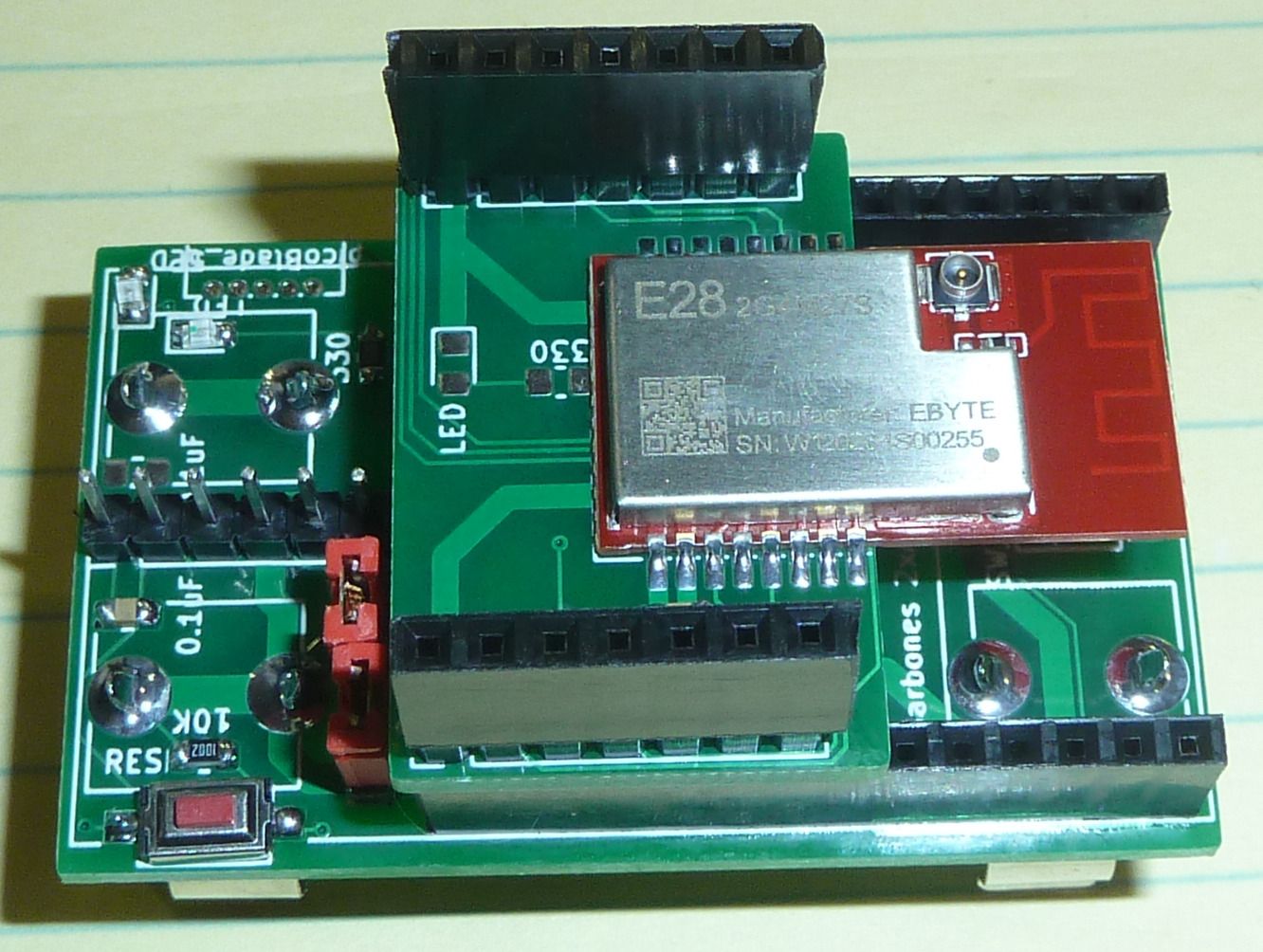
I expect this version will be fully Dupont compatible with the PPK2 probe pins. Unfortunately, if you look carefully you'll see that the adapter PCB covers up the nearest header pin hole beneath it on either side of the board. Ooops! I'll have to fix that in the next revision of the adapter board. For now it's no biggy, though: it's PPK2 access to the pins on the adapter board that matter most, and those are now fully exposed for probing.
-
@Larson said in Anyone using/tried the E28-2G4M27S 2.4Ghz LoRa SX1280 27dB module?:
@NeverDie The radio pads look like even I can hit them with solder.
When I'm designing module PCB landing pads, I almost always make them longer than what the datasheet recommends to make orienting the module and soldering it in place easier. In contrast, the datasheet always specifies the absolute minimum.
-
@NeverDie said in Anyone using/tried the E28-2G4M27S 2.4Ghz LoRa SX1280 27dB module?:
if you look carefully you'll see that the adapter PCB covers up the nearest header pin hole beneath it on either side of the board.
Yea, but a Dremmel snip job would have those two pins accessible in a flash! In my hackish world, there has to be three errors to warrant redsign... unless it is an unrecoverable error, of course!
-
@Larson Are you able to get input to work on any of the 8 PPK2 sense pins? Mine isn't responding at all. They all read high, even if I connect one of them directly to PPK2 ground. Matter of fact, I'm not even getting any voltage out of the logic analyzer's VCC pin. If yours is working, then maybe mine is defective or something.
Where were you able to get yours from? The place I ordered from no longer has them in stock. I'm debating whether to backorder from mouser. Argh. I hope it doesn't come to that. Weird that the current portion of the PPK2 is working, but not the logic analyzer part.
I've submitted a ticket to Nordic and contacted the seller, but of course nothing happens very quickly and I probably won't hear from them anytime soon.
-
@NeverDie The PPKII arrived yesterday! I've only cracked it out of the box and haven't tried. I'll do so next. Been spending my time in KiCAD tutorials, looking at your boards and taking care of family! I'm like an excited dog in a 3-D field of fire-hydrants! Never enough time for a slow-reader like me.
My PPKII source: DigiKey 5/24/22 order. Here is the scoop off the invoice (most importantly the part no): PART: 1490-NRF-PPK2-ND MFG : NORDIC SEMICONDUCTOR ASA / NRF-PPK2 DESC: POWER PROFILER KIT 92.50000 92.50 COO : POLAND ECCN: EAR99 HTSUS: 8543.70.9860 ROHS3 COMP REACH UNAFFECTED 25-JUN-2020
It sure came fast for being back-ordered.I also received a bunch of other solder stuff you recommended and a solder plate. Again, too excited, but life is getting in the way. Radio’s are on their way, mostly from AliExpress. Too bad they fractionalize one order; now I’ve got about a dozen different order-tracking email threads.
PPKII test: I’m planning on a vanilla ProMini with and without the conventional crystal – per your tutorial. I will throw in a signal cue on a pin to test the logic analyzer thing. Will that be sufficient to test? Hope to report by the end of the week if the distractions end.
Then I’d like to try the PPKII on the Darrah Trig Board; I know, I can’t read the deep sleep with a PPK, but it will be a good first-try for me with the Trig Board.
-
@NeverDie said in Anyone using/tried the E28-2G4M27S 2.4Ghz LoRa SX1280 27dB module?:
Matter of fact, I'm not even getting any voltage out of the logic analyzer's VCC pin.
Maybe a stupid question... but are you powering from the PPKII source, or the device-under-test battery? Does it matter? I know nothing about the PPKII, yet. But I have read that the burden voltage is an issue even on the PPKII. I have no idea if the LA is complicated by this.
-
@Larson said in Anyone using/tried the E28-2G4M27S 2.4Ghz LoRa SX1280 27dB module?:
@NeverDie said in Anyone using/tried the E28-2G4M27S 2.4Ghz LoRa SX1280 27dB module?:
Matter of fact, I'm not even getting any voltage out of the logic analyzer's VCC pin.
Maybe a stupid question... but are you powering from the PPKII source, or the device-under-test battery? Does it matter? I know nothing about the PPKII, yet. But I have read that the burden voltage is an issue even on the PPKII. I have no idea if the LA is complicated by this.
I've tried it both ways, and I'm just not getting anything out of the logic port.
-
@Larson said in Anyone using/tried the E28-2G4M27S 2.4Ghz LoRa SX1280 27dB module?:
Will that be sufficient to test? Hope to report by the end of the week if the distractions end.
I imagine so.
-
@NeverDie said in Anyone using/tried the E28-2G4M27S 2.4Ghz LoRa SX1280 27dB module?:
I know nothing about the PPKII, yet. But I have read that the burden voltage is an issue even on the PPKII.
And, I think I learned about the PPKII burden voltage from you!
-
@Larson said in Anyone using/tried the E28-2G4M27S 2.4Ghz LoRa SX1280 27dB module?:
@NeverDie said in Anyone using/tried the E28-2G4M27S 2.4Ghz LoRa SX1280 27dB module?:
I know nothing about the PPKII, yet. But I have read that the burden voltage is an issue even on the PPKII.
And, I think I learned about the PPKII burden voltage from you!
The PPK2 seems to work fine when powering the circuit whose current it is measuring, but if externally powered then, yes, for some reason it seems to choke the DUT.
Because the PPK2 is out-of-stock everywhere, I decided that rather than be held prisoner by whatever lengthy return/warranty cycle for my PPK2 is likely to be, I would upgrade my o-scope to one that can do integrations and sell my old scope, which can't do integrations. New scope should arrive on Thursday.
If you're wondering how that works, this explains it:
EEVblog #662- How & Why to use Integration on an Oscilloscope – 19:53
— EEVblogAs you can see, the UI is nowhere near as nice as the PPK2 for measuring current consumption. Perhaps offsetting that somewhat is that the o-scopes resolution should be better: the PPK2 has 100,000 samples per second, whereas these days a decent entry-level o-scope will commonly have 1 giga-samples/second.
I still like the PPK2, and I look forward to exchanging the one I have for one that works.
-
@NeverDie I have no experience with an O. Scope, or a PPKII. I presumed the OS gives one much more dimension of analysis. But as indicated my Harbor Freights DMM delivers nearly everything I need. Sure is fun to listen to Dave Jones. The man is a source of knowledge and excitement spiced with humor.
-
Good news! My PPK2 works after all. After experimenting, I determined that '"VCC" on the logic port is not a voltage source, as its name would imply. Instead, it is a voltage sense pin. So.... the way to make the logic port work is to wire the logic port VCC to the VOUT (or to whatever VCC that's powering your project). After doing so, D0 through D7 work as you would expect.
Also worthy of note: there evidently are no internal pull-up or pull-down resistors on any of the D0-D7 logic port sense pins. So, if, for example, you give D0 a high pulse and then disconnect from it, D0 will tend to stay high until it receive a low pulse.
Happy I don't need to return/exchange the PPK2 after all.

-
@Larson Something I only just recently started using in the last couple of days that you may like: 0.4mm diameter Kester Rosin solder. It's ridiculously thin, but for soldering radio modules onto boards, I'm finding that I can more precisely put just enough solder exactly where I want it without having to apply solder flux to the module afterward.
-
@NeverDie said in Anyone using/tried the E28-2G4M27S 2.4Ghz LoRa SX1280 27dB module?:
Glad to hear you solved it. I was hoping to help you, for a change. You are too fast for me. I just got home from a grueling day.
So, if, for example, you give D0 a high pulse and then disconnect from it, D0 will tend to stay high until it receive a low pulse.
By 'disconnect' do you mean sleeping? It sounds like Pull-Up/Down on the DUT pin would solve it. Ohhh, I'm thinking that disconnect means when the MCU disengages the PPKII. Or perhaps VCC pin is at play. I know so little of the PPKII, but I would imagine it couldn't have any Pull-Up/Down assignments or it would be fighting the DUT Pull direction. The result of double pulls would be a voltage divider and give some misleading indications.
-
@Larson said in Anyone using/tried the E28-2G4M27S 2.4Ghz LoRa SX1280 27dB module?:
@NeverDie said in Anyone using/tried the E28-2G4M27S 2.4Ghz LoRa SX1280 27dB module?:
Glad to hear you solved it. I was hoping to help you, for a change. You are too fast for me. I just got home from a grueling day.
So, if, for example, you give D0 a high pulse and then disconnect from it, D0 will tend to stay high until it receive a low pulse.
By 'disconnect' do you mean sleeping? It sounds like Pull-Up/Down on the DUT pin would solve it. Ohhh, I'm thinking that disconnect means when the MCU disengages the PPKII. Or perhaps VCC pin is at play. I know so little of the PPKII, but I would imagine it couldn't have any Pull-Up/Down assignments or it would be fighting the DUT Pull direction. The result of double pulls would be a voltage divider and give some misleading indications.
By disconnect I just mean, for example, taking a wire that's connected to D0 and touching it to GND and then pulling the wire away so that it's no longer touching GND. It's not something you would do "in real life," but I was doing it just to confirm that the PPK2 was working.
-
@NeverDie said in Anyone using/tried the E28-2G4M27S 2.4Ghz LoRa SX1280 27dB module?:
0.4mm diameter Kester Rosin solder.
I'll put it on my list. After the Male/Female antennae discussion above, I'm sure I got my order wrong - so I'll have a new running list shortly when everything arrives. I checked my solder with a caliper since the dimensions are listed in Chinese: it is 0.6 mm so I'm not far away. I do like the feel the smaller diameter has in comparison to my larger solder so I'm sure 0.4 mm will even be better.
-
@Larson said in Anyone using/tried the E28-2G4M27S 2.4Ghz LoRa SX1280 27dB module?:
@NeverDie said in Anyone using/tried the E28-2G4M27S 2.4Ghz LoRa SX1280 27dB module?:
0.4mm diameter Kester Rosin solder.
I'll put it on my list. After the Male/Female antennae discussion above, I'm sure I got my order wrong - so I'll have a new running list shortly when everything arrives. I checked my solder with a caliper since the dimensions are listed in Chinese: it is 0.6 mm so I'm not far away. I do like the feel the smaller diameter has in comparison to my larger solder so I'm sure 0.4 mm will even be better.
Yeah, I was using 0.635mm MG Chemicals solder previously, but I found I had to drown the radio modules in rosin flux afterward to eliminate solder bridges, etc. Perhaps part of the difference may be that Kester uses a different formulation for its in-line flux than MG Chemicals? I suppose that could also have something to do with it. So, maybe it's not entirely diameter, but having now worked with the two different diameters, my gut intuition is that the smaller diameter is helping.
Anyone else reading this having any opinions on the matter that they are willing to share?
-
@Larson said in Anyone using/tried the E28-2G4M27S 2.4Ghz LoRa SX1280 27dB module?:
I checked my solder with a caliper since the dimensions are listed in Chinese: it is 0.6 mm so I'm not far away.
Ha, I just did the simple math. Since the cross-sectional area is function of the squared radius, 0.4 is vastly different (better?) than the 0.6 mm. The 0.4 mm will feed 2.25 times as fast as the 0.6 mm for the same volume - maybe even more if there is a higher evaporative flux component. That is a big difference.
-
@NeverDie said in Anyone using/tried the E28-2G4M27S 2.4Ghz LoRa SX1280 27dB module?:
Anyone else reading this having any opinions on the matter that they are willing to share?
I'm sure there are. Initially, I was not only occasional but also reluctant to comment due to my lack of credible contribution. You helped me overcome that. This thread will be a resource for a multitude of others that will be too late for contemporary comment. Keep on going, man.
Today's achievement for me: PPK2 software is loaded (not that simple) and it is funcitoning. Super cool metrics. I'll shortly post my crystal/non-crystal measurements for my own enjoyment.
-
@NeverDie said in Anyone using/tried the E28-2G4M27S 2.4Ghz LoRa SX1280 27dB module?:
@Larson said in Anyone using/tried the E28-2G4M27S 2.4Ghz LoRa SX1280 27dB module?:
@NeverDie said in Anyone using/tried the E28-2G4M27S 2.4Ghz LoRa SX1280 27dB module?:
0.4mm diameter Kester Rosin solder.
I'll put it on my list. After the Male/Female antennae discussion above, I'm sure I got my order wrong - so I'll have a new running list shortly when everything arrives. I checked my solder with a caliper since the dimensions are listed in Chinese: it is 0.6 mm so I'm not far away. I do like the feel the smaller diameter has in comparison to my larger solder so I'm sure 0.4 mm will even be better.
Yeah, I was using 0.635mm MG Chemicals solder previously, but I found I had to drown the radio modules in rosin flux afterward to eliminate solder bridges, etc. Perhaps part of the difference may be that Kester uses a different formulation for its in-line flux than MG Chemicals? I suppose that could also have something to do with it. So, maybe it's not entirely diameter, but having now worked with the two different diameters, my gut intuition is that the smaller diameter is helping.
Anyone else reading this having any opinions on the matter that they are willing to share?
I swear by the stuff in the picture below. It melts at a lower temperature(179 C) so, as an amateur, I feel safer keeping my iron at a lower temp and in place a little longer when I am working with IC's. I like that it's thin too as it is easier to control how much you apply. I have no issues with it, it flows well and doesn't create bridges (unless I use too much).
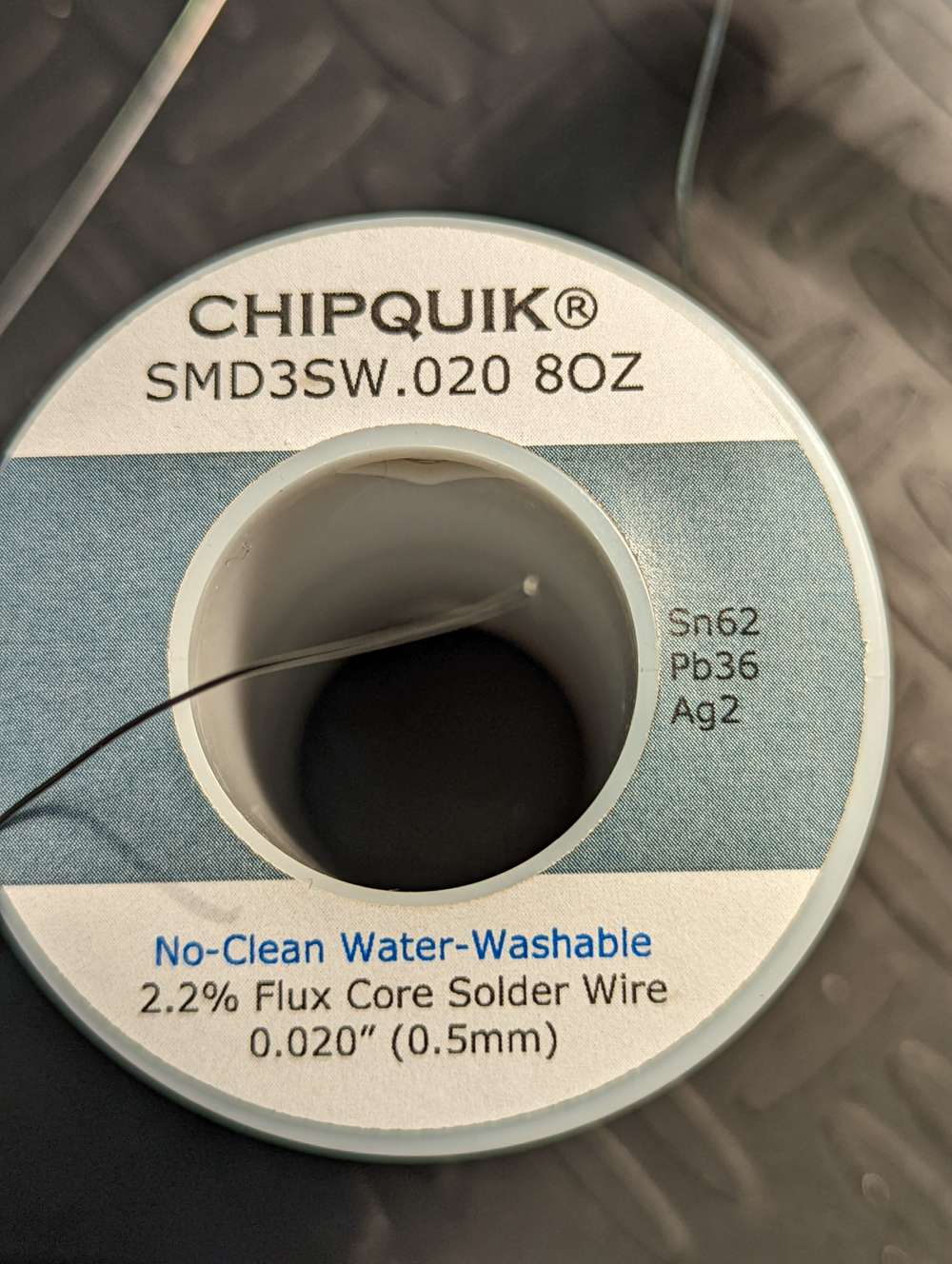
-
@alphaHotel Thanks for the tip! I added it to my mouser shopping basket.
Like Dave from EEVblog I tend to run my soldering pencil hotter than I should but work quickly to compensate, so maybe with this Chipquik solder I can dial it down. For sure the Chipquik desoldering solder works extremely well.
-
@alphaHotel & @NeverDie: My ChipQuik kit arrived as did the SRA flux. Look forward to working with it. I find the "No-Clean" claim concerning but I am armed with my new 99% alcohol just in case.
@NeverDie: The PPK2 is great. I did a few tests and captures today - no logic-port evaluation yet. It will take me another day to learn the fuse settings. Yes, Gammon is the master of the fuse subject as I learned with PIC chips. More on PPK2: I’m using the LowPower library (Felix R. I think). After sleep, the PPK tells me that the current is 4 uA. Zeesh, with the 18650 LiOn battery decay rate of 28’ish uA, I’m not sure if I need fuse settings. Well, there is the optimization of the thing, so I will press on.
-
@Larson Yeah, I think of "No Clean" as really being "easier to clean." There's still some residue with those that I have tried, but they really are easier to clean up after than the regular flux.
So I still prefer them, but I don't like to leave them uncleaned. Maybe the residue isn't corrosive like regular flux? At any rate I don't trust it either.
-
@NeverDie said in Anyone using/tried the E28-2G4M27S 2.4Ghz LoRa SX1280 27dB module?:
@Larson Here's all you need to know in one place on how to get to 100na sleep current on the atmega328p: https://www.gammon.com.au/power He covers all the different methods. TL;DR: burn your fuses to:
External: 0xFF
High: 0xDC
Low: 0xC2
and then run Sketch J from the Nick Gammon link. That's all there is to it, provided you have an external device/circuit to wake up your atmega328p.It sounded so simple. Today I gave it a shot. The fuse setting is just like I remembered it: complicated. The bottom line is that, using Sketch J, I am able to get down to 0.25 uA even without changing fuses. Not that I didn’t try to change fuses. I got out my USBASP and have been bootloading and fuse-setting all day. I used avrdude and had trouble getting the commands to work right (conf file directory must be specified.) I tried your recommended fuse settings but then couldn’t upload programs. So, I changed back to default fuse settings and still couldn’t upload programs. Seems to be that another bootloader reset got me back to normal. So… if I can get to 0.25 uA, I’m super happy. The additional 0.1 uA reduction is just too difficult for me. I'm not exactly sure how this helps in the radio stuff, but it has been a really good excercise of my new PPK2 device. I am very impressed.
I’m kind of shocked that the PPK2 has that granularity. As Gammon indicated with Sketch J, I could ground D2 (INT0) to cause an interrupt to blink the LED. That on its own is a valuable tool. Here is a picture. Thanks for holding my hand in this stuff – it has been most helpful.
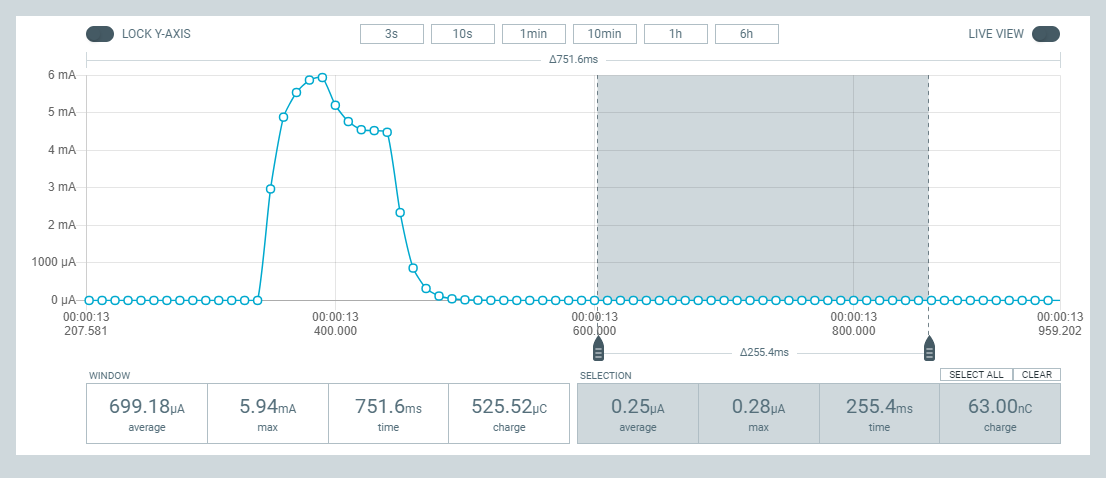
-
@NeverDie said in Anyone using/tried the E28-2G4M27S 2.4Ghz LoRa SX1280 27dB module?:
Something I only just recently started using in the last couple of days that you may like: 0.4mm diameter Kester Rosin solder. It's ridiculously thin, but for soldering radio modules onto boards, I'm finding that I can more precisely put just enough solder exactly where I want it without having to apply solder flux to the module afterward.
I'm out shoping for this solder. I can find this 20 mil solder, but not the 0.4 mm (16 mil) stuff. Do you have a link?
-
@alphaHotel said in Anyone using/tried the E28-2G4M27S 2.4Ghz LoRa SX1280 27dB module?:
I swear by the stuff in the picture below. It melts at a lower temperature(179 C) so, as an amateur, I feel safer keeping my iron at a lower temp and in place a little longer when I am working with IC's. I like that it's thin too as it is easier to control how much you apply. I have no issues with it, it flows well and doesn't create bridges (unless I use too much).
On your recommendation I'm looking for this solder as well. For those who follow this thread I found it here.
The solder diameter that came with my Chipquick SMD1 Removal kit was enough for one job, maybe. The linked 4 Oz. supply will last some time for me.
-
@Larson said in Anyone using/tried the E28-2G4M27S 2.4Ghz LoRa SX1280 27dB module?:
I'm out shoping for this solder. I can find this 20 mil solder, but not the 0.4 mm (16 mil) stuff. Do you have a link?
It is Kester 24-6337-0007 https://www.amazon.com/KESTER-SOLDER-24-6337-0007-WIRE-183°C/dp/B00DDDHF2W/ref=sr_1_2?keywords=Kester+24-6337-0007&qid=1655879942&sr=8-2 That's half the price that mouser would charge for the exact same thing. Go figure.
-
@Larson said in Anyone using/tried the E28-2G4M27S 2.4Ghz LoRa SX1280 27dB module?:
On your recommendation I'm looking for this solder as well. For those who follow this thread I found it here.
The solder diameter that came with my Chipquick SMD1 Removal kit was enough for one job, maybe. The linked 4 Oz. supply will last some time for me.That's not quite the same stuff. What I use has a small amount of silver content in the alloy. You can find it here at Mouser.com. The smallest size they have though is the 8oz which is basically, a lifetime supply for me at least.
-
@NeverDie and
@alphaHotelThanks for the links. I'm going for the silver (Ag)! The little that I remember from physics is that silver has high conductivity and low melting point. Perfect. Too bad it is so expensive.
I have a few dental crowns that could be remelted and ...
-
From the MySensors forum entry:
@NeverDie said in Anyone using/tried the E28-2G4M27S 2.4Ghz LoRa SX1280 27dB module?:
Hmmmm... Something's wrong then with Adafruit's design if it's 20uA. The chip itself consumes only 35na according to its datasheet:
https://www.ti.com/lit/ds/symlink/tpl5110.pdf?ts=1652658923819&ref_url=https%3A%2F%2Fwww.google.com%2FMy TPL5110's arrived and I hooked one up to the PPKII to take a look. Remember that Adafruit advertised a disappointing OFF-state current of 20 uA. Fortunately, I have found this not to be the case. Instead, my PPKII shows the off state to be 120 nA; picture attached. The load I used was an LED hooked up to a resistor and the PPK is supplied with 3.3V. As earlier discussed, I’ll next dig out the TrigBoards that Kevin Darrah sent me to see how they do.
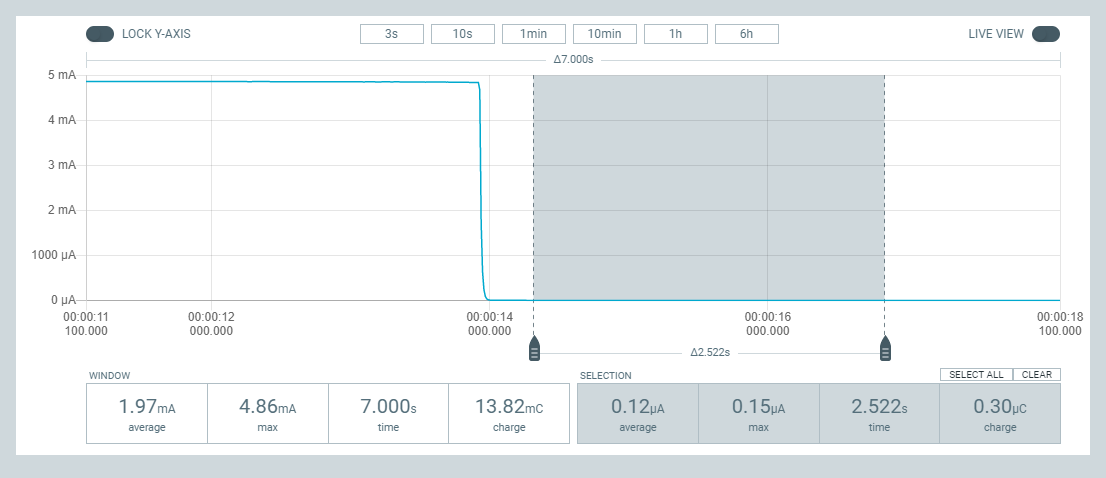
-
@Larson Thanks for posting your measurements. Mine match up with yours: https://forum.mysensors.org/topic/11954/most-reliable-best-radio/20?_=1656174349755
I just yesterday put together a TPL5111 to serve as purely a wake-up timer for a sleeping MCU, and it's working well also in that capacity.
-
@NeverDie Here is my report on the Kevin Darrah Trigboard (V8.1) as promised. Fundamentally, the power draw of this board is about as low as the TPL5110. His board ships with door monitoring firmware on it that is conducting some kind of polling every 320 mS, it appears. Between the polling the current draw is about 180 nA, per my PPKII. If one were to include the polling activity, then the average current is about 1.3 uA. A picture of this is below. If an alarm condition is achieved, the device makes an internet connection and broadcasts a message to third-party servers that will alert the user by phone/text/email. Of course, that takes time (between 2 to 3 seconds), and additional current.
If you have 30 minutes, Kevin has a start-up video that is very informative. He makes the point that this board consumes a small fraction of what smoke detectors use. While the PPKII shows that the Trigboard has an equivalent sleep current, the Trigboard delivers the monitoring function for additional, though modest, current. As before, I find value in comparing these tiny currents to the expected shelf-life burn rate that is orders of magnitude (at least one) higher.
This was my first exposure to ESP32’s. Kevin indicates that the performance of the ESP32 is better than the ESP8266. I like the idea of Bluetooth access for being able to configure devices, as Kevin shows, and for access to sensor data – especially in development & debugging. I have not reviewed his firmware that he generously has made available. His “Configurator” firmware looks to be a great example of how to build user menus to input variables. This looks like the new form of the older WiFi Manager libraries which have been very useful.
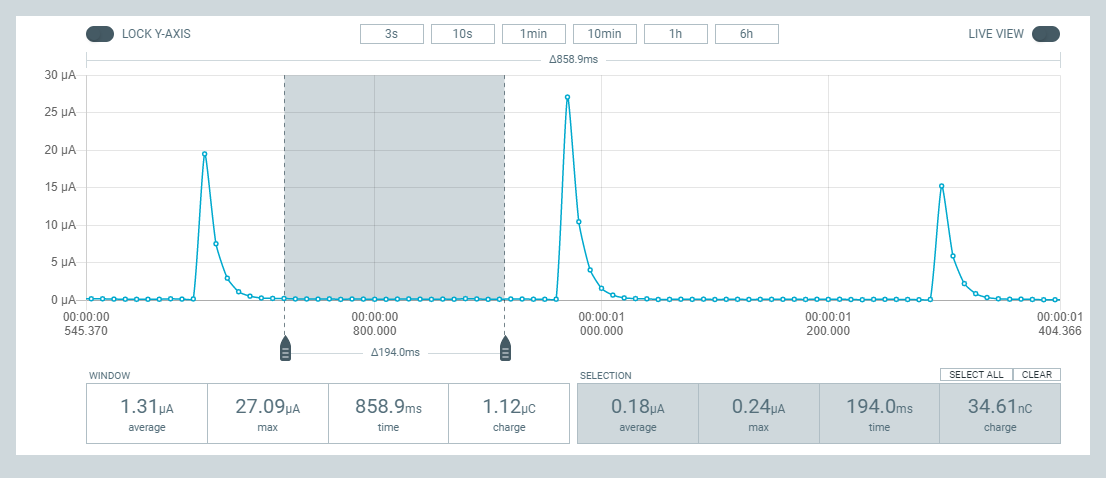
-
@Larson I haven't studied Kevin's solution, so maybe I'm missing the point of it, but the adafruit TPL5110 BoB is so much less expensive and draws so little current that it seems like no contest to me.
-
@NeverDie You have a point. The TPL is also simpler.
But bless the developer. Yes, I was trying to hype his product. I forgot to mention that doing this current test was really easy because this thing just worked... right out of the box (really, out of the anti-static bag.) Rarely have things work so quickly for me. Even the TPL required fumbling.
So if sleeping is the objective and timing isn't really important, then the TPL it is. But if configuration settings, Bluetooth, ADC, I2C, SPI and timing are relevant, then the Trigboard is the way to go.
-
@NeverDie said in Anyone using/tried the E28-2G4M27S 2.4Ghz LoRa SX1280 27dB module?:
https://mcudude.github.io/MiniCore/package_MCUdude_MiniCore_index.json
It's very easy to use. You can install it into the regular Arduino IDE, pick from among the MiniCore "boards" in the board manager, select the 8Mhz option and a few other obvious options, and then you're done with instalation. From that point on your code will automagically compile using MiniCore. Just to be sure, I gave it a try myself, and I'm now blinking a blue LED off of Ardino Pin 20. It works!I leave this post as a reminder to anyone else reading this thread. The MCUDude link and installation step is VERY important. To install in the Arduino IDE add the link in File/Preferences/Additional Board Manager URLs; go to Board Manager and filter on minicore, click on Install when MiniCore comes up. Next when selecting the MiniCore board, make sure to select Clock as Internal (8 MHz), or avrdude won't be able to find your board. I went with the other board manager defaults and ... WaLa... my new barebones board is blinking on both pins 20 and 21. Overlooking, or not remembering, this May 14 post has cost me several weeks. So if you build yourself a barebones, heed this post.
-
@Larson said in Anyone using/tried the E28-2G4M27S 2.4Ghz LoRa SX1280 27dB module?:
@NeverDie said in Anyone using/tried the E28-2G4M27S 2.4Ghz LoRa SX1280 27dB module?:
https://mcudude.github.io/MiniCore/package_MCUdude_MiniCore_index.json
It's very easy to use. You can install it into the regular Arduino IDE, pick from among the MiniCore "boards" in the board manager, select the 8Mhz option and a few other obvious options, and then you're done with instalation. From that point on your code will automagically compile using MiniCore. Just to be sure, I gave it a try myself, and I'm now blinking a blue LED off of Ardino Pin 20. It works!I leave this post as a reminder to anyone else reading this thread. The MCUDude link and installation step is VERY important. To install in the Arduino IDE add the link in File/Preferences/Additional Board Manager URLs; go to Board Manager and filter on minicore, click on Install when MiniCore comes up. Next when selecting the MiniCore board, make sure to select Clock as Internal (8 MHz), or avrdude won't be able to find your board. I went with the other board manager defaults and ... WaLa... my new barebones board is blinking on both pins 20 and 21. Overlooking, or not remembering, this May 14 post has cost me several weeks. So if you build yourself a barebones, heed this post.
Thanks for your post. I just now pasted it into the project's main description page on openhardware.io: https://www.openhardware.io/view/22651/Version-30-atmega328p-test-platform
-
@Larson
I suppose the design could be changed to include an optional diode on pin 13 for those who want to stay strictly orthodox Arduino.One could also allow a crystal oscillator to be installed, for those who want that as well, but I happen to think running from a crystal oscillator is generally a bad idea for a battery powered application, especially when the 8Mhz resonator seems to work so well.
-
@NeverDie said in Anyone using/tried the E28-2G4M27S 2.4Ghz LoRa SX1280 27dB module?:
...but I happen to think running from a crystal oscillator is generally a bad idea for a battery powered application...
No, don't change the design. I think you have a platform with a specific low power intent - including the education of others (like me). Matter of fact, I've got several battery projects that would be FAR better by changing to the on-chip clock, and new core. And so far, we are only using the 8 MHz setting. In the MiniCore the choices go to 1 MHz.
Back when I was... on PIC's... I bought 32 KHz crystals to minimize power. I just didn't know enough to use them and I still don't. But I'm working that direction and you have helped A BUNCH including you're idea of friends sitting around the table exchanging bits and bytes in a MISO/MOSI/SCK kind of way. I'm gathering that if you have control of the clock, you could have it all.
Besides you, Kevin Darrah, and Felix @ LowPowerLabs have also made great contributions to the low-power idea. I just haven't dedicated enough energy, yet, to their efforts.
16 MHz is impractically fast when so many designs just need low power.
I wanna go back to school,
DogWithA_Bone
-
Here are the pin labels for the V001 barebones board for mounting on headers. The document I prepared for this wouldn't upload, but had nice lefthand/righthand orientations. This made it easier than having to open the CAD file everytime I needed to make connections.
But here is what I did in MS Word:
Turn on grid set spacing to 0.1"
Turn on ruler
Copy the below text
Align to the right or left as you wish
Font Calibri 5.5
Verify spacing (14 pins = 1.4")
PrintI also made columns and multiple copies of the below with both alignments. I have two boards built. Maybe you have more. Hope it helps.
GND
D5
D7
D9
D10/SS
D11/MOSI
D6
D8
A0
A1
VCC
GND
A5/SCL
A4/SDAVCC
D4
D3
D13/SCK
D12/MISO
D2/INTO
A5/SCL
A4/SDA
A3
A2
VCC
GND
A5/SCL
A4/SDADTR
RXTX
TXRX
VCC
X
GND[8/6/22 edit: reversed TX and RX as noted above - just incase someone has use for it]
-
-
@NeverDie Yea, I think I knew you upversioned the silkscreen. I think I remember you commenting on it. Looks pretty. BUT in my effort to add to the community, since I typed it for my self for my V001 boards, I thought I'd share it incase there is anybody like me with V001.
I like the V003 upgrades, specially that reset bypass via as discussed with @alphaHotel . Maybe I'll try it. I've got so much into my little V001's (yours actually) that I just can't give-em up. When I get the boards rigged up with radios, GPS (on the USART bus) and SD Card reader (on the SPI bus with a different CS), I'll shoot and send a picture in the spirit of a party!
-
@Larson Okay, No picture party yet. But, I did get a notification from Digikey that the Atmega328P-AN is back in stock for $3 each.
-
@NeverDie today I re-read the fcc rules and I may have mislead you back in https://forum.mysensors.org/post/111853
It seems like the fcc rules say that if you use more than 500kHz bandwidth, you don't need to use frequency hopping, and there is no dwell time requirement.
(2) Systems using digital modulation techniques may operate in the 902-928 MHz, 2400-2483.5 MHz, and 5725-5850 MHz bands. The minimum 6 dB bandwidth shall be at least 500 kHz.
I don't understand why fcc encourages applications to hog a big portion of the spectrum but it looks like you can go willy-nilly if you just use enough bandwidth.
-
2.4GHz LoRa modules offer a good data rate compared to lower frequency ones that are very limited on this aspect, but they suffer path loss much more and wide use of 2.4GHz increase interference problem a lot.
I'm interested to know how they perform in typical urban use scenarios.
Has someone tested E28-2G4M27S in urban environment?
I have found only test result of people in very good condition as line of sight with no buildings or other obstacle interposed or at very short range (from a room to another in same building).
-
@NeverDie I have noticed that in the latest version of your adapter you have lowered the capacitor value used for the first stage filtering from 100uF to 10uF, leaving the second stage one to 0.1uF. Did you have empirical benefit in tests with this configuration? 0.1uF it seems to me at first glance too small to accommodate current draw fluctuation of this module. Would be appreciated if you explain your design choice. Thank you.
-
@SMH17 said in Anyone using/tried the E28-2G4M27S 2.4Ghz LoRa SX1280 27dB module?:
@NeverDie I have noticed that in the latest version of your adapter you have lowered the capacitor value used for the first stage filtering from 100uF to 10uF, leaving the second stage one to 0.1uF. Did you have empirical benefit in tests with this configuration? 0.1uF it seems to me at first glance too small to accommodate current draw fluctuation of this module. Would be appreciated if you explain your design choice. Thank you.
The 10uF isn't for filtering. It's just to prevent voltage droop at the radio when the radio starts to pull current. So, yes, testing reveals that it seems adequate for that purpose. I originally slotted in 100uF because I wasn't sure, and overkill is better than underkill. It's possible that 10uF may also be overkill....
-
@NeverDie @Larson Have you had success with the Ra-01SH? I'm having trouble using high SF values (11, 12) with low bandwidth (<250 kHz). I wanted to know if you had the same experience and if you have other recommendations for sx126 modules if I just want really long ranges.
-
@haxn2 I don't recall there being any problems of the type you describe. You didn't say what kind of "trouble" you were having, but, if anything, the high coding factor and narrow bandwidth should improve range, unless there is interference in the narrower band. Have you tried changing the frequency? Are you sure you're using a suitable antenna? Exactly what kind of range are you trying to achieve?
-
@haxn2 https://github.com/jgromes/RadioLib/issues/388 might be useful
-
^^^This. Good point. Maybe do some testing with RadioLib to see whether or not you experience the same problem.
